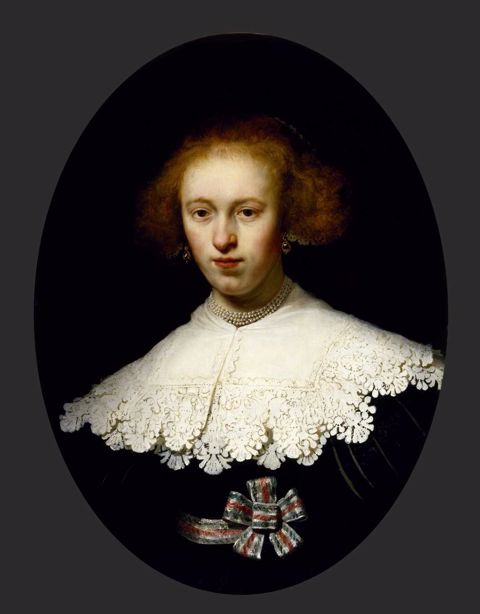Reinstallation of MFAH Galleries for European Art

Rembrandt van Rijn, Portrait of a Young Woman, 1633, oil on wood, the Museum of Fine Arts, Houston, Museum purchase funded by various lenders in memory of Caroline Wiess Law.
Viceregal Mexican, Biombo with Views of Mexico City (left screen), 18th century, six-panel folding screen; oil on red maki-e lacquer on panel, with gilt wood mounts and linen backing, the Museum of Fine Arts, Houston, Museum purchase funded by the Agnes Cullen Arnold Endowment Fund.
Viceregal Mexican, Biombo with Views of Mexico City (right screen), 18th century, six-panel folding screen; oil on red maki-e lacquer on panel, with gilt wood mounts and linen backing, the Museum of Fine Arts, Houston, Museum purchase funded by the Agnes Cullen Arnold Endowment Fund.
Reinstallation of MFAH galleries for European art spans the Middle Ages through the 18th century; northern and southern Europe to Central and South America
Major recent acquisitions and several exceptional loans debut in a presentation that features paintings, tapestries, sculpture, liturgical objects, and antiquities
HOUSTON–June 6, 2022–On Wednesday, June 8, the Museum of Fine Arts, Houston, will open a major new reinstallation of 11 galleries for European art. Spanning the Middle Ages through the 18th century, with art from northern and southern Europe as well as Central and South America, the interdisciplinary presentation features paintings, tapestries, sculpture, liturgical objects, and antiquities across 500 years of cultural and artistic production.
“This new, interdisciplinary presentation furthers a new approach to our collections,” commented MFAH director Gary Tinterow. “Following on the reinstallation of our American galleries, in 2020, we have similarly rethought the display of our European collections to more fully express the history, culture, and faith in which these works were originally created and experienced. Having actively acquired decorative arts and liturgical objects over the last several years, we will now present these new acquisitions in context with paintings, prints, and drawings, including many examples from the permanent collection that have been rarely displayed.”
The galleries’ overarching narrative tells a comprehensive story of European art, with works of varied media throughout that illustrate how textiles, sculpture, decorative arts, books, works on paper, and paintings functioned together within their original contexts. Several galleries highlight specific areas of achievement in early modern Europe and the Viceroyalty of New Spain, including 16th-century Netherlands and Venice, and 17th-century Spain and its colonies in Central and South America. Notably, three galleries trace the relationship between 17th-century Spanish art and the art of the Viceroyalty of New Spain in the 17th and 18th centuries, exploring the relationship between European art and the art of the Americas.
Several major recent acquisitions and exceptional loans will be placed on view. These include:
- A recently acquired, rare, 18th-century lacquered folding screen, or biombo, from Mexico. A view of Mexico City, the screen’s detailed panorama captures the diversity and cosmopolitanism of the capital, depicting architectural monuments and European and indigenous citizens from varied social strata. The 12-panel biombo is modeled on the Japanese folding screen, introduced to this area of New Spain through trading routes in the early 17th century.
- A singular portrait miniature of Henri III, King of France, by the renowned 16th-century court artist Jean de Court, another recent acquisition. Dated 1578, the piece was discovered in 2020 in an online regional auction by a U.K. art dealer. It is believed to be the only artwork still in existence bearing de Court’s signature.
- Significant objects recently acquired from the renowned French decorative arts collection of Horace Wood Brock, including a rare long-case clock attributed to the 17th-century French cabinet maker to King Louis XIV, André Charles Boulle.
- Two Florentine Renaissance objects on loan from private collections. One, newly discovered and never before seen in the United States, is a glazed-terracotta tondo, or round relief, by Andrea della Robbia, The Madonna in Adoration of the Christ Child Surrounded by Angels, with God the Father (1470–75). The second is an exceptionally rare painted-terracotta bust of Christ (c. 1480–83) by the sculptor and mentor of Leonardo da Vinci, Andrea del Verrocchio. The bust is the exact likeness of Verrocchio’s famous Christ from the façade of the church of Orsanmichele in Florence, where the figure is paired with Saint Thomas, which was created during the same period.
- Nine paintings from the collection of Carl and Marilynn Thoma are the centerpiece of a gallery for 18th-century paintings produced in South America during Spanish colonial rule.
The 11 galleries feature some 200 objects, organized across nine groupings: The Medieval Era; Late Medieval and Early Renaissance Art; 16th-Century Roman Art; 16th-Century Netherlandish and German Art; Renaissance Portraits; Art in 16th-Century Venice; 17th-Century Italian and French Baroque Art; 17th-Century Dutch Art; and 17th-Century Spanish and Viceregal Art.
About the Museum of Fine Arts, Houston
Spanning 14 acres in the heart of Houston’s Museum District, the main campus comprises the Audrey Jones Beck Building, the Caroline Wiess Law Building, the Lillie and Hugh Roy Cullen Sculpture Garden and the Nancy and Rich Kinder Building. Nearby, two house museums—Bayou Bend Collection and Gardens, and Rienzi—present collections of American and European decorative arts. The MFAH is also home to the Glassell School of Art, with its Core Residency Program and Junior and Studio schools; and the International Center for the Arts of the Americas (ICAA), a leading research institute for 20th-century Latin American and Latino art. mfah.org
Media Contact
Melanie Fahey, Senior Publicist
mfahey@mfah.org | 713.800.5345
